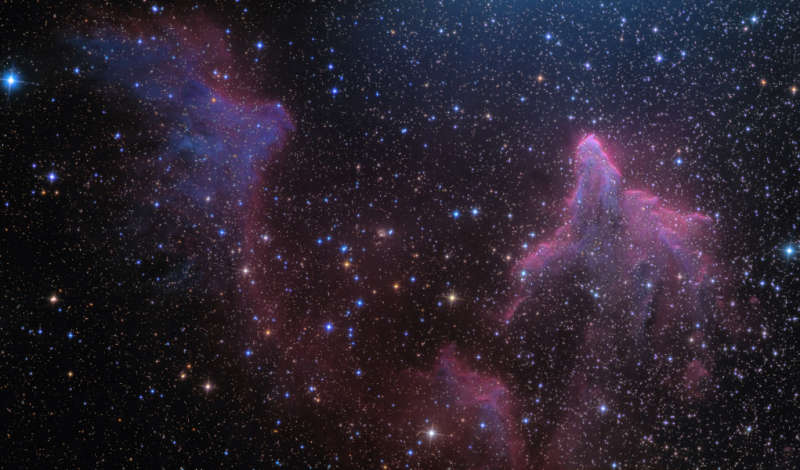Credit & Copyright: Ken Crawford
(Rancho Del Sol Obs.)
Explanation:
These bright rims and flowing shapes look ghostly on a cosmic scale.
A telescopic view toward the constellation
Cassiopeia, the colorful
(zoomable) skyscape features
the swept-back, comet-shaped clouds IC 59 (left) and IC 63.
About 600 light-years distant,
the clouds
aren't actually ghosts, but they are slowly disappearing under
the influence of energetic
radiation from hot,luminous star gamma Cas.
Gamma Cas is physically
located only 3 to 4 light-years from the
nebulae, just off the top right edge of the frame.
Slightly closer to gamma Cas, IC 63 is dominated by
red H-alpha light emitted as
hydrogen atoms ionized by the star's ultraviolet radiation recombine
with electrons.
Farther from the star, IC 59 shows proportionally less H-alpha
emission but more of the characteristic blue tint of dust
reflected star light.
The field of view spans about 1 degree or 10 light-years at the
estimated distance of
gamma Cas and friends.
1999 2000 2001 2002 2003 2004 2005 2006 2007 2008 2009 2010 2011 2012 2013 2014 2015 2016 2017 2018 2019 2020 2021 2022 2023 2024 2025 |
Yanvar' Fevral' Mart Aprel' Mai Iyun' Iyul' Avgust Sentyabr' Oktyabr' Noyabr' Dekabr' |
NASA Web Site Statements, Warnings, and Disclaimers
NASA Official: Jay Norris. Specific rights apply.
A service of: LHEA at NASA / GSFC
& Michigan Tech. U.
|
Publikacii s klyuchevymi slovami:
reflection nebula - emission nebula - Kassiopeya - otrazhatel'nye tumannosti - emissionnaya tumannost'
Publikacii so slovami: reflection nebula - emission nebula - Kassiopeya - otrazhatel'nye tumannosti - emissionnaya tumannost' | |
Sm. takzhe:
Vse publikacii na tu zhe temu >> | |
